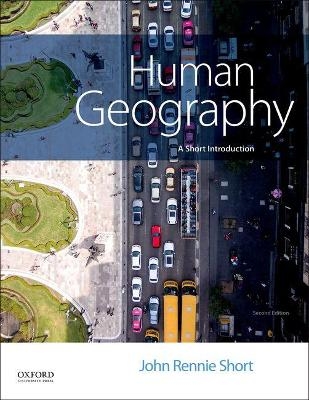
Human Geography
Oxford University Press Inc (Verlag)
978-0-19-067983-5 (ISBN)
robust support package, Human Geography: A Short Introduction, Second Edition, presents unparalleled flexibility and value for both students and professors.
John Rennie Short is Professor of Geography and Public Policy at the University of Maryland, Baltimore County. The author of thirty-seven books and numerous papers in academic journals, Dr. Short is the recipient of awards from the National Science Foundation, the Environmental Protection Agency, the National Geographic Society, and the Social Science Research Council.
Preface
PART 1. The Context
1. The Home Planet
The Big Picture
Box 1.1 Poor Pluto
Shaky Ground: Plate Tectonics
Life on Earth
A Humanized World
Box 1.2 Wallace's Line: A Biogeographical Boundary
2. The Nature of Geography
Mapping Absolute Space
Box 2.1 Measuring the World
The Shift from Cosmography to Geography
Box 2.2 Thinking about Maps
Mapping Relative Space
Environment and Society
Geography and Society
Contemporary Debates
Box 2.3 The Spatial Turn
The Concerns of Human Geography
Box 2.4 GIS, Remote Sensing, and The Democratization of Mapping
PART 2. People, Resources, and Environment
3. Population Dynamics
Population Declines
Box 3.1 The Reproductive Revolution
The Demographic Transition
Box 3.2 Ireland: The Demographic Base of the Celtic Tiger
Phases of the Demographic Transition
Box 3.3 Brazil and the Demographic Dividend
Box 3.4 Russia's Changing Population
Problems and Opportunities of The Demographic Transition
4. Population and Food
Population and Agriculture
Malthusian Melancholy
Hunger, Famine, and Food Insecurity
Box 4.1 Overfishing
Box 4.2 Food Deserts
Limits on Food Supply
Questioning the Food Production System
Box 4.3 Overpopulation Reexamined
5. Population and Resources
The Case of Coal
Box 5.1 The Hubbert Curve
Laws of Resource Use
The Limits to Growth?
The Case of Oil
Box 5.2 The Geopolitics of Oil
Fracking in The USA
Box 5.3 Commodity Cartels
The Limits to Growth Revisited
6. People and the Environment
Environment and Cultural Meaning
Environmental Impacts on Society
Human Impacts and Environmental Change
The Anthropocene: Living in a Modified Earth and Socially Constructed Nature
Box 6.1 The Tragedy of the Commons?
PART 3. The Economic Organization of Space
7. The Geography of Three Economic Sectors
Agriculture
Box 7.1 Food Supply Chains
The Commercialization of Agriculture
Manufacturing
Box 7.2 The Industrial Revolution
Services
Box 7.3 The Cultural-Creative Economy
Summary
8. The Economic Geography of Uneven Development
Global Differences
Box 8.1 Different Economies
Regional Differences
The Role of The State
Capital and Labor
The Rise of Mass Consumption
Box 8.2 The Changing Concerns of Economic Geography
PART 4. The Cultural Organization of Space
9. The Geography of Population
The Distribution of Population
Population Differences: Gender, Age, Race, and Ethnicity
The Movement of Population
Box 9.1 The Age of Distraction
Models of Population Movement
Box 9.2 The Zelinksy and Metz Models
10. The Geography of Religion
The Geography of the Major Religions
Box 10.1 Alternative Visions
The Geographies of Religious Belief
The Religious Organization of Space
Box 10.2 Jerusalem
Religion and Society
11. The Geography of Language
Language of the Local
The Distribution of Languages
Language and Power
The Language of Place
The Place of Language
The Political Geography of Language
Globalization of Language
Box 11.1 The Linguistic Landscape
PART 5. The Global Organization of Space
12. Creating a Global Economy
Space-Time Convergence
Three Waves of Globalization
Box 12.1 The Flow of Capital
Box 12.2 The Flow of Remittances
Global Shift
Box 12.3 Transnational Corporations
International Non-Government Agencies
The Promise and Reality of Neoliberalism
A Flat World?
13. The Global Geography of Culture
Cultural Regions
Spatial Diffusion
Box 13.1 The Diffusion of Diseases
Culture as Flow
The Global Production of Culture
The Commodification of Culture
The Myth of Homogeneity
PART 6. The Political Organization of Space
14. World Orders
Early Empires
Global Integration
Box 14.1 The Caribbean as Imperial Shatter Zone
Imperial Overstretch
Imperial Disintegration
The Clash of Civilizations?
Elements of A New World Order
Box 14.2 The Pentagon's View of the World
15. The Nation-State
The Range of States
Box 15.1 Depicting Countries in Relative Space
The Rise and Fall of States
The Spatial Nature of the State
Box 15.2 Imagined Communities
Nation, State, and Minorities
The Territory of the State
Boundaries and Frontiers
Geography of Elections
Box 15.3 Geopolitics
PART 7. The Urban Organization of Space
16. The Urban Transformation
The First Urban Revolution
A Second Urban Revolution
The Third Urban Revolution
Box 16.1 The Metropolitan United States
Box 16.2 Megalopolis
Box 16.3 Seoul
Box 16.4 Shanghai
17. Networks of Cities
Regional Networks
National Networks
Box 17.1 Estimating City Population
Global Networks
Box 17.2 Visualizing National Urban Network Flows: The Case of the United States
18. The Internal Structure of the City
The City As Investment
The City As Residence
Box 18.1 Home Sweet Home
The City as Social Context
Box 18.2 Measuring Segregation in Cities
The City As Political Arena
Box 18.3 Population Change in US Cities, 1900-2010
Changes in the Contemporary City
Glossary
Credits
Index
| Erscheinungsdatum | 27.07.2017 |
|---|---|
| Zusatzinfo | Illustrations |
| Verlagsort | New York |
| Sprache | englisch |
| Gewicht | 1300 g |
| Themenwelt | Naturwissenschaften ► Geowissenschaften ► Geografie / Kartografie |
| Sozialwissenschaften ► Soziologie ► Makrosoziologie | |
| ISBN-10 | 0-19-067983-2 / 0190679832 |
| ISBN-13 | 978-0-19-067983-5 / 9780190679835 |
| Zustand | Neuware |
| Haben Sie eine Frage zum Produkt? |
aus dem Bereich



